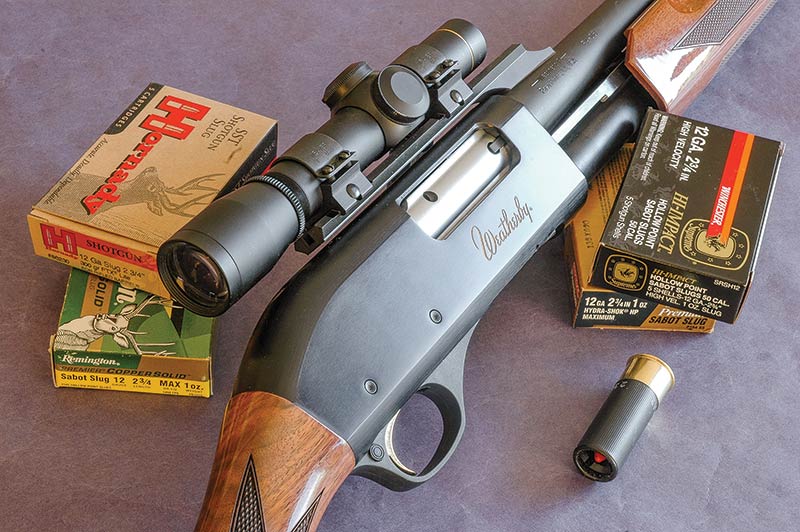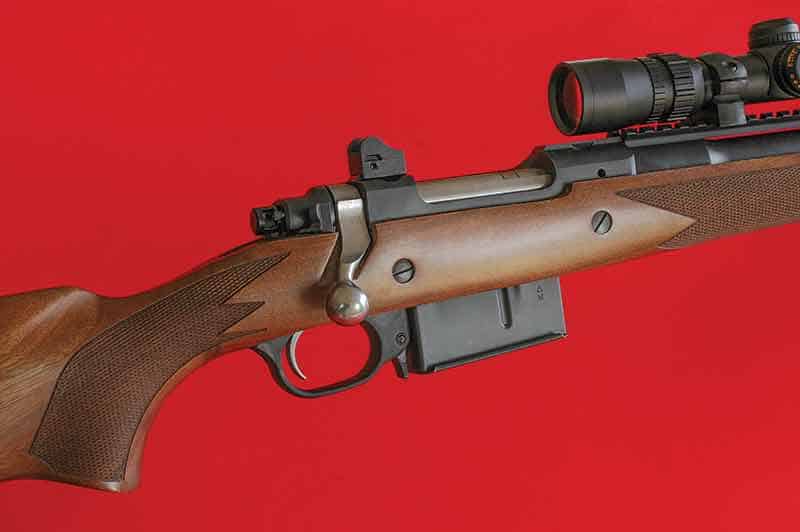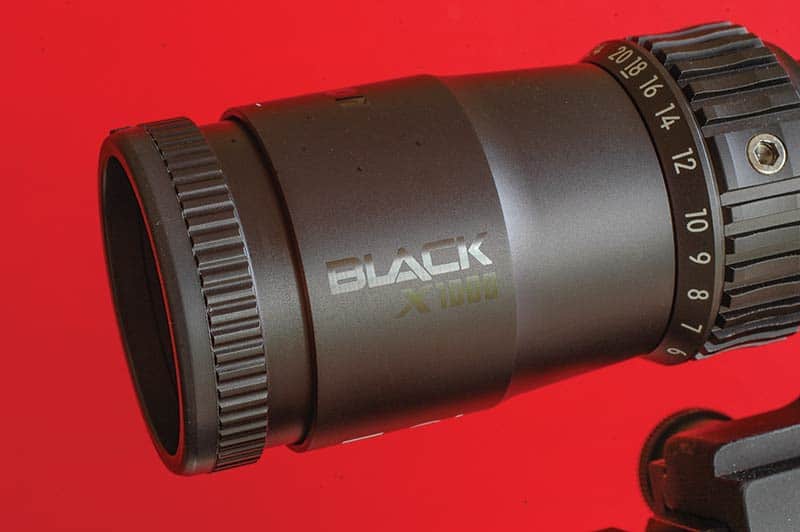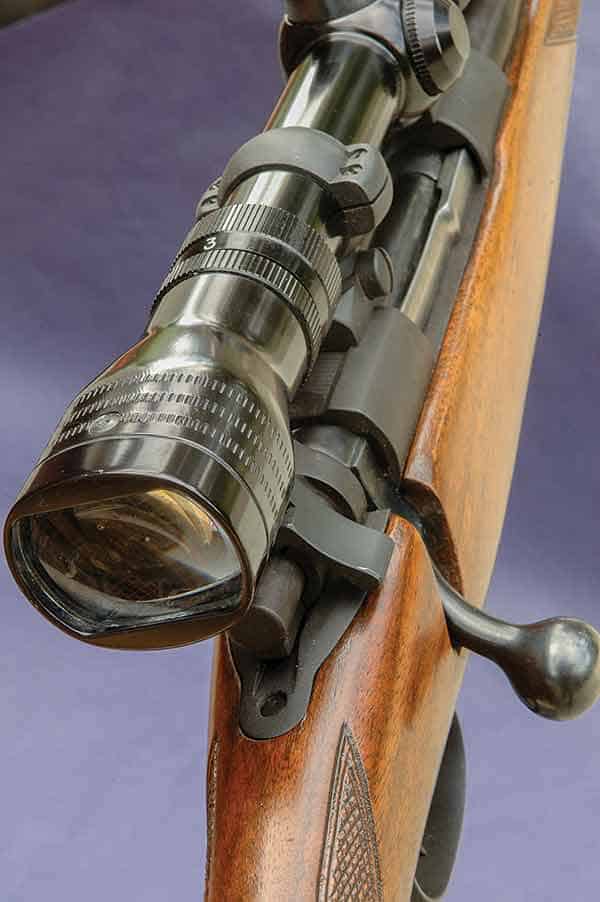The longer a scope’s ER, the smaller its field. Witness an LER handgun scope or an IER scope on a Scout rifle. Most scopes designed for receiver mounting on rifles have 3 to 4" of ER. Dialing up a variable from low to high magnification, you might well see ER shrink.
Arguably, scopes for the masses date to 1930 and Bill Weaver’s 10-oz., 2¾X Model 330. It had a 3/4" steel tube 10½" long, a 35-foot FOV and an ER of 3½". Next came the similar 4X 440, its 27-ft. FOV also limited by an eyepiece little bigger than the tube. Soon 7/8" tubes (as in Lyman’s Alaskan) appeared. After WWII, alloy replaced steel in 1" tubes and eyepieces blossomed like umbrellas behind them. FOVs grew.
At its 1953 debut, a 4X Leupold Mountaineer boasted a 35-ft. field. Six years after Leupold’s Vari-X II in 1965, Redfield had a Widefield scope, its generous rear lens blocked top and bottom to yield a TV-screen field. Low Profile Widefields followed in 1975. Their tubes were flattened too. The merits of squashing a perfectly good circle was lost on many shooters.
Bringing Up the Rear
Ocular Lens Lessons
It’s a love/hate relationship. Bloodied by scopes on rifles as mild-mannered as the .223, I could, out of spite, dismiss scope eyepieces as simply punishing but I’ll take the high road. While pie-plate front glass, smart turrets, miracle lens coatings and astronomy-level power bring showers of confetti, the back ends of scopes remain in the shadows. They deserve better.
Engineers tell me optical design is comprehensive. “You can’t tweak one thing without adjusting others. Also, what’s behind your rear scope ring affects both what you see and how well you can shoot.”
Field of View
First there’s field of view. Commonly designated in linear feet at 100 yards, field can also be expressed as an angle. Importantly, what you see through any scope is area. The areas of circles are proportionate to the squares of their diameters. A scope’s 200-yard FOV is four times the area of its 100-yard field. Before you dial up from 4X to 16X afield, realize your linear FOV will shrink roughly from 30 feet to 7. And you’ll see less than 1/16th the area.
Magnification affects FOV, but so do ocular lens diameter and optimal eye relief. With your eye in aiming position, a cone of view extends from your pupil to the lens perimeter. Say the cone angle is 24 degrees, and the scope a 6X. What you see is a magnified image, so actual field is the 24-degree angle divided by the power.
A 24-degree angle at 100 yards spans about 120 feet: 120/6 = 20 feet. To enlarge the field you could trim magnification to 4X: 120/4 = 30 feet. Or you could make the ocular lens bigger for a wider cone angle — say, 30 degrees. This would net you a 25-foot field at 6X, a 37½-foot field at 4X. You could also reach those figures with the original lens by reducing eye relief. This is because as your eye gets closer to the lens, the cone angle increases.
Binoculars have wide fields, courtesy of short eye relief (ER). But binos don’t whack your noggin. When you ignite a small bomb to force a bullet through a snug pipe at Mach 3, everything that doesn’t move forward backs up. ER keeps your brow stitch-free. Incidentally, non-critical ER isn’t long or short; it’s forgiving to yield a full FOV if your eye isn’t the optimal distance from the lens.
Mounts, Reticles, Tubes
Bigger eyepieces and power-change rings on scopes prompted tweaks in rifles and mounts. The bolt-handle shoulders and rear safeties of pre-war Winchester Model 70s went away. Mount rings pushed forward by power-change mechanisms shortened eye relief, prompting mount extensions.
Until the late 1950s, adjusting windage and elevation moved the reticle — zeroing usually put it off-center in the field. Solution: Install a rear-plane reticle in the erector tube and pivot the tube at the rear so W&E dials moved the front of the tube relative to objective glass without disturbing the reticle.
I recall spinning eyepieces off scopes and regarding with wonder (but not touching!) their reticles before Leupold used nitrogen to fog-proof tubes and sealed them. If taking optics apart seems foolish on its face, consider the Zeiss Tak-A-Part scope of 1958. The four-piece design lets shooters slip one-piece rings over the tube inside ocular and objective bells.
As 30mm tubes replace 1″ ones and bigger objectives bring higher rings, eyepieces keep growing. They’re also getting longer (4″) and ever closer to the eye. Rubber bumpers are showing up on lens perimeters. Another change: fast-focus or “European” eyepieces, rotating on helical threads inside the bell instead of on fine external threads with a lock ring. Either type focuses the reticle. Aim at a blank, neutral field and twist until the reticle appears sharp. You won’t change this setting until age changes your eyes.
Presumably, it will leave your brow intact until then.









